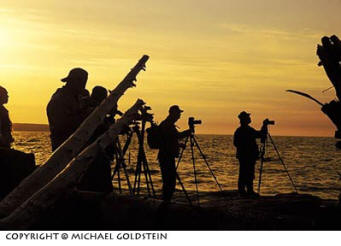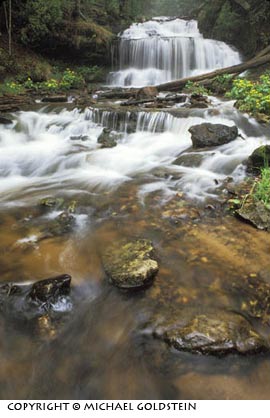
Sunset Photographers
Sand Point, just outside Munising, Michigan, was a place to which we went twice, to catch the sunset. As it began to develop, I was able to make this silhouette image of part of the group, preparing for their own shots. Shots such as these are easy – you simply expose for the bright sky, and your foreground (you gotta have a foreground!) becomes a silhouette. I used my 300mm zoom lens for this shot, cropping in tightly on the group.
I’m standing in the middle of a country road that runs through the woods. As far as I can see on both sides of the road, acres and acres of white trillium (Trillium grandiflorum), Ontario’s provincial flower, are waving in the breeze. These are more trillium than I’ve ever seen after forty years of living in Ontario. The funny thing is, I’m not in Ontario. I’m within five miles of Munising, in Michigan’s Upper Peninsula, and I’ve discovered wildflower heaven. I don’t believe it. Close-ups, environment shots, portraits–my shutter finger begins to itch. Where’s my macro lens?
I’ve made the long drive from Toronto to be here in the middle of May to participate in Rod Planck’s nature photography workshop. My personal passion is working with wildflowers, and it looks like my timing is perfect. I left home wearing t-shirt, shorts, and sandals, but this is the UP. I’ve brought a full Goretex rain suit, poly long johns with matching top, several fleece sweaters, toque and gloves, and my well-tested waterproof hiking boots. On several of our morning expeditions this week, I’ll wear all of these–and be glad to have them!
I’ve arrived a day early for the workshop. It’s dark and cloudy overhead, perfect weather for shooting flowers, and I indulge myself for several hours. It’s also perfect light for photographing waterfalls. The UP is famous for its many cataracts, some of which are spectacular. Wagner Falls and Alger Falls, two of the more scenic ones, are located just outside Munising, off Highway 94.
It used to be possible to photograph Alger Falls from the road, but over the years since my last trip, a number of small trees have grown up to block the view. I manage to climb up the embankment and around the trees, and
make a few more images for my files.

Wagner Falls, located an easy stroll from Highway 94 outside Munising, Michigan, is easy to reach, and easy to photograph from a viewing platform. The best images are made, however, by climbing down from the boardwalk, and placing your tripod in the stream.
With the unstable gun platform of the stream bed under my tripod, I decide not to risk my relatively new Nikon. Instead, I made this image using my venerable Canon A1, with a 17mm rectilinear lens.
Without spot metering available, I established the exposure using an old and trusted technique. I measured the light from the palm of my hand, and with a dark cloudy day, used that as the basis for a manual exposure, bracketing up and down a half f-stop. Thirty – year old technology can still produce good photographs!
Wagner Falls, a location which requires a short stroll along a boardwalk over a marsh, offers many more compositional opportunities. Slow shutter speeds on dark days produce lovely veils on moving water, while a polarizer reveals the details in the stream bed. It’s possible to make good photographs of this falls from the viewing platform at the end of the boardwalk. To my mind, however, if you’re not ankle-deep in the stream below the falls, with a wide-angle lens and your tripod, you’re cheating. (Don’t knock your camera into the water!) Both falls support wonderful patches of marsh marigolds that are at their peak in May and glow in the subdued light.
Our first workshop morning finds us overlooking Miner’s Castle, a famous rocky outcropping on the shores of Lake Superior. Since my last visit here, part of the “turret” has fallen into the lake! Rod’s initial lecture, delivered while bald eagles fly overhead, is about composition and how to do low-impact nature photography. We are urged to watch where we place our feet and how we swing our tripod legs. This talk includes tips on self-defense, such as checking our clothing for wood ticks when we emerge from the bush and walking out of the woods to change films to avoid the entrapment of black flies (boy, do we have black flies!) in our cameras. As the light improves, Rod wraps up his presentation and sends us off to play for a couple of hours. This location is a wildflower cornucopia, and I’m soon immersed in white trilliums, Dutchman’s breeches, forget-me-nots, Canada white violets, spring beauties, and squirrel corn, some of which I’ve not seen before.
While we shoot, Rod and Marlene Planck circulate, offering ideas on exposure techniques and composition, as well as botanical insights. It soon becomes evident that they are both knowledgeable botanists, as well as experienced photographers. I had long realized that doing good flower photography demands close attention to small details, but Marlene takes this concept to a new high. Noticing that I am using a large folding reflector to shade my background, she suggests that using a proper diffuser, instead, will cause less color shift on film; the shadow I’m presently throwing is far too cool in color temperature. This is a revelation!
My special interest in taking this workshop is to fill a “hole” in my photographic knowledge–the use of spot metering with manual exposure, and the compensation necessary for many types of nature images. I used to meter light from my hand, then open up a stop–or two or three–for years, using my old Canon gear (a la John Shaw’s ideas), but today’s cameras allow far more precision. Rod’s printed handout on the workshop (mailed to me weeks in advance so I could practice!) explores this technique in great depth. During the workshop itself, both Rod and Marlene will hammer the idea at every opportunity, with lots of illustrative slides. I’ll leave with far more confidence in using these metering ideas than when I arrived.
As a teacher, Rod shines. He is patient, organized, speaks well and slowly, and is an expert at what he does. His imagery is wonderful, and he has the teaching experience to be able to present his ideas in several different ways. With two decades of serious photography behind me, I look for at least one new idea, either tactical or technical, when attending a workshop. Did I find one?
-
“When doing macro photography, bracket for focus, as well as for exposure. If the wind is blowing, shoot twice as many images and play the odds!”
-
“Bright white subjects may require 1.5 – 2.5 f-stops of compensation. Dark subjects, which reflect some light, should be compensated less–never as much as 2 f-stops.”
-
“First, determine your basic composition and tripod position while handholding the camera. Then, position your tripod and finalize your composition. Only then do you remove the camera from the tripod, establish your exposure, and replace the camera on the tripod and make your image.”
…And on and on.
Our workshop participants come from diverse backgrounds with varying amounts of experience. One fellow begins a two-mile hike carrying two tripods. Another drops his expensive camera in a fast-flowing river. One of our ladies hikes the wet and muddy UP trails in socks and sandals. Last year, at a workshop in Mexico, half of the participants were shooting color slides. In this workshop, I’m the only one not using a digital camera–a sign of the times. As is usually the case, great ideas flow back and forth within our group–during field trips, over meals, and in lecture sessions. Put any collection of keen photographers in an interesting location, impose intensive image-making upon them, and everyone should return home enriched, and motivated.
By Michael Goldstein

Leave a Reply